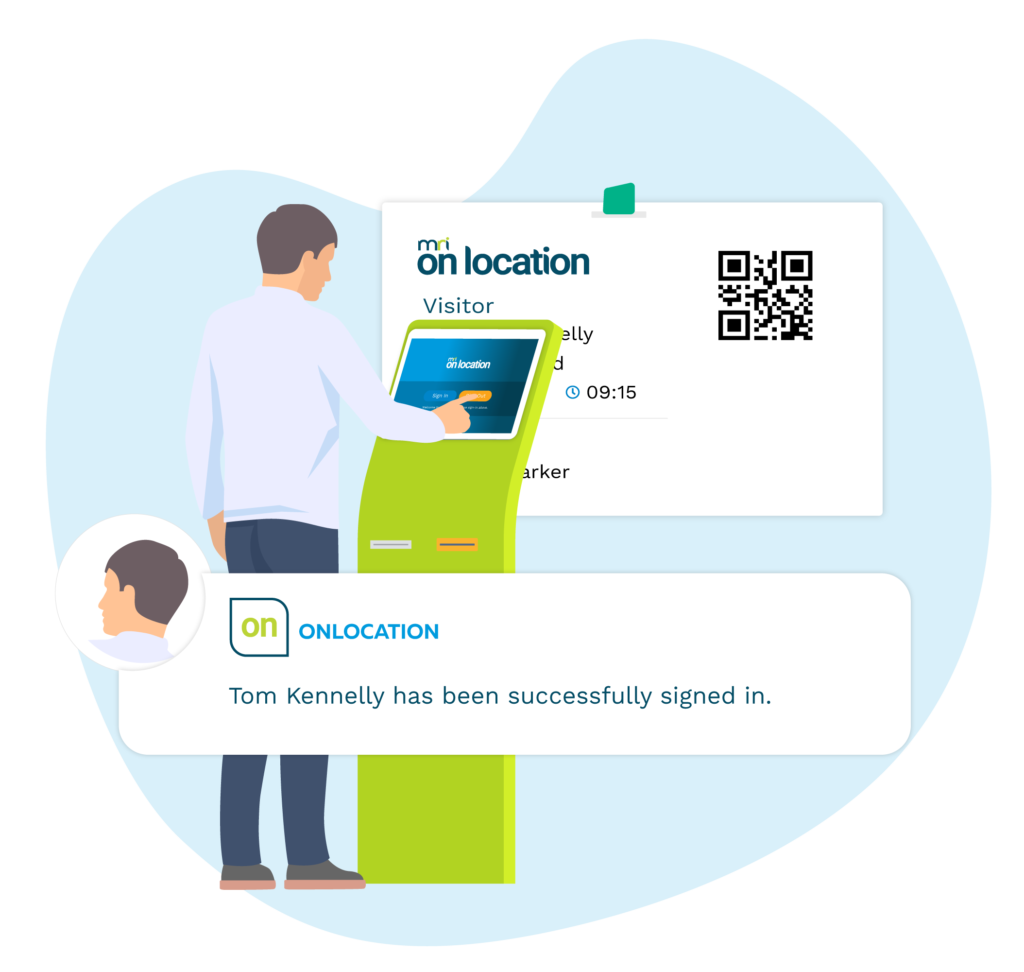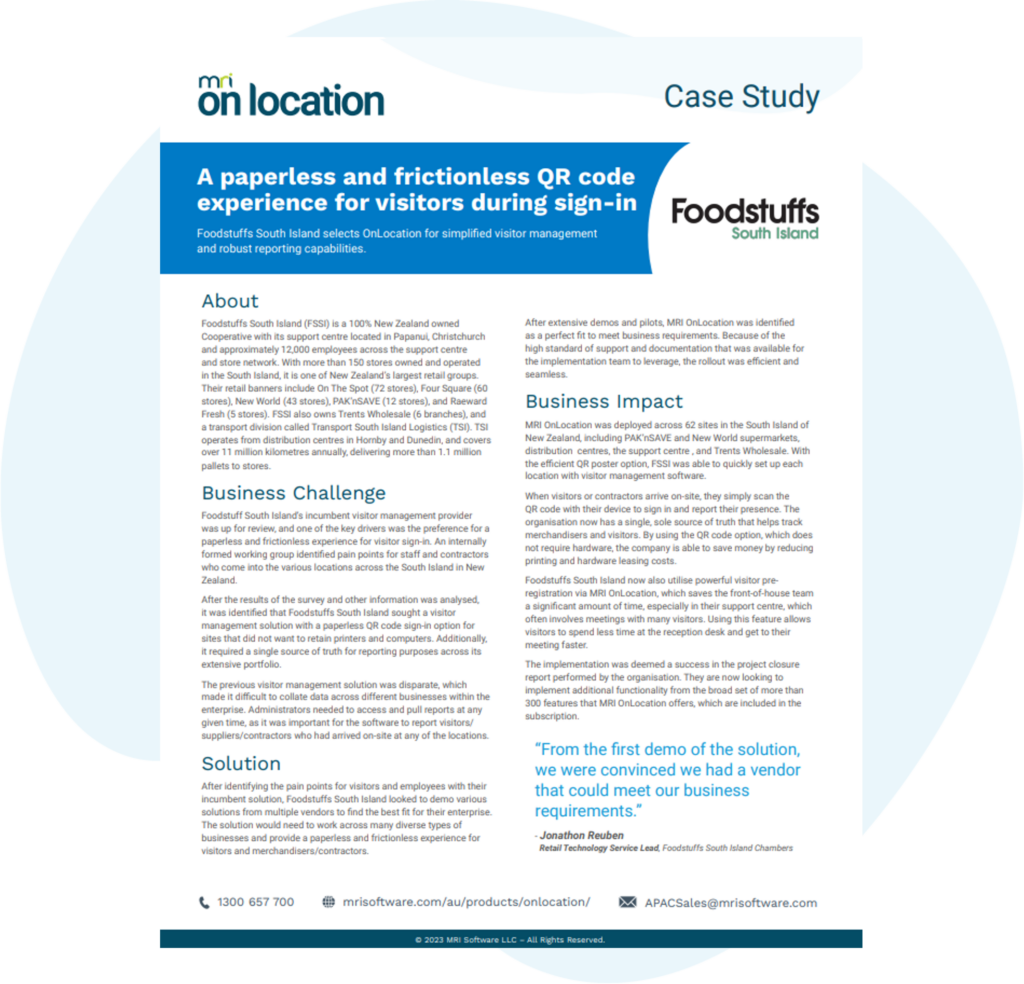Types of visitor management systems
Managing visitors efficiently is essential for businesses looking to maintain security, compliance, and a seamless experience. With the variety of visitor management systems available today, companies can choose the solution that best fits their needs, from simple paper-based systems to advanced biometric technologies.
MRI Software offers cutting-edge solutions tailored to meet the demands of modern businesses, including multi-tenant visitor management systems, which streamline visitor management for properties with multiple tenants. Their visitor management system provides innovative features to enhance security, improve efficiency, and integrate with existing building systems. Additionally, we discuss the benefits of cloud-based visitor management systems, offering flexibility and scalability to suit businesses of all sizes.
Get the visitor management software brochure
Screen, track and report on all site visitors.

Paper-based sign-in systems
Despite technological advancements, paper-based sign-in systems remain common, especially in smaller businesses or organisations with minimal visitor traffic. These systems are straightforward and inexpensive, relying on physical logbooks where visitors manually enter their details.
However, the limitations of paper-based systems are significant. They offer minimal security, as anyone can access visitor information simply by flipping through the pages. These systems make it difficult to maintain accurate records, as illegible handwriting or incomplete information can lead to errors. For companies that need to track visitor data for compliance or auditing purposes, a paper system might not be the most reliable solution. It also lacks the capability to alert staff when a visitor arrives, meaning the process can be slow and inefficient.
While some businesses may still rely on these systems, many are moving towards more sophisticated, tech-driven solutions that offer increased security and efficiency.
On-premises visitor management systems
On-premises visitor management systems represent a significant upgrade from paper-based solutions. These systems use software installed directly on a company’s servers or computers, often requiring dedicated hardware like tablets or kiosks for visitors to check in. On-premises systems allow for customisation based on the company’s unique requirements and can be integrated with other security systems, such as CCTV or badge printing services.
A major benefit of these systems is the level of control they provide. Since all data is stored on-site, businesses with strict privacy or compliance needs may prefer this type of system. However, on-premises systems can be costly to maintain, requiring regular updates and IT support to ensure everything functions smoothly. Additionally, they may not be as flexible as cloud-based options, particularly when it comes to scalability or remote access.
While this type of system is ideal for businesses with a strong IT infrastructure and specific security requirements, it may not be the best option for companies looking for an easily scalable or low-maintenance solution.
Cloud-based visitor management systems
Cloud-based visitor management systems are becoming increasingly popular due to their flexibility, scalability, and ease of use. These systems store visitor data on secure cloud servers, meaning businesses can access and manage this information from any device with an internet connection. This makes them ideal for organisations with multiple locations or those looking for a system that can grow with their business.
Cloud-based systems offer real-time updates and can often be integrated with other software, such as building management systems or customer relationship management (CRM) tools. This enables companies to streamline visitor management across all departments, improving overall efficiency.
Cloud-based systems reduce the need for on-site maintenance and IT support, as software updates and security patches are handled by the service provider. This makes them an attractive option for businesses that want to minimise the burden on internal IT teams. However, organisations that require complete control over their data may have reservations about using cloud-based systems due to potential security concerns.
Mobile app-based systems
Mobile app-based visitor management systems are designed for businesses that prioritise mobility and convenience. These systems allow visitors to sign in using a smartphone or tablet, either through a company-provided device or their own personal phone. This eliminates the need for physical kiosks or reception desks, making it an excellent choice for modern, flexible workplaces or businesses with a high volume of visitors.
One of the key advantages of mobile app-based systems is their ability to streamline the check-in process. Visitors can pre-register through the app, reducing wait times and enabling staff to prepare for their arrival. Some systems even offer contactless sign-ins, further enhancing convenience and security.
However, while mobile app-based systems are convenient, they may not be suitable for every organisation. Businesses with older visitors or those less familiar with technology may find that these systems can cause confusion or frustration. Mobile-based solutions rely on strong internet connectivity and may not perform well in areas with limited network coverage.
Web-based systems
Web-based visitor management systems operate through a browser interface, meaning they can be accessed from any device with internet access, including desktop computers, tablets, or smartphones. Like cloud-based systems, web-based solutions offer real-time access to visitor data, allowing companies to manage multiple locations or remote offices efficiently.
These systems typically offer many of the same benefits as mobile app-based or cloud-based solutions, such as streamlined check-ins, pre-registration options, and integration with other management tools. Web-based systems are often user-friendly and require minimal training for staff, making them an attractive option for businesses looking to implement a visitor management system quickly.
One potential drawback is that web-based systems, like mobile app-based ones, depend on internet access. Organisations in areas with unreliable internet may experience interruptions or delays when using the system. Nonetheless, for businesses with reliable internet infrastructure, web-based systems provide a flexible and scalable solution.
Integrated systems
Integrated visitor management systems combine various elements, such as access control, security cameras, and employee communication tools, into one seamless platform. These systems are ideal for larger organisations or businesses with specific security needs, such as government buildings, hospitals, or corporate offices.
By integrating visitor management with existing security measures, businesses can enhance both efficiency and safety. For example, an integrated system might automatically alert staff when a visitor enters a restricted area or print a visitor badge with access to specific parts of the building. Some systems also offer advanced reporting features, allowing businesses to track visitor patterns, ensure compliance, and identify any security risks.
Integrated systems can be complex to set up and may require significant IT resources to maintain. Businesses considering this option should weigh the benefits of enhanced security and functionality against the potential costs and complexities.
Biometric systems
Biometric visitor management systems use fingerprint scanning, facial recognition, or other biometric data to identify visitors. These systems offer a high level of security and are often used in facilities where tight access control is required, such as data centres, laboratories, or high-security government buildings.
One of the main benefits of biometric systems is that they are virtually impossible to forge, providing an additional layer of security over traditional ID cards or badges. They also allow for fast, efficient check-ins, as visitors can simply scan their biometric data rather than entering personal information manually.
However, the cost of biometric systems can be prohibitive for smaller businesses, and some visitors may have privacy concerns about providing their biometric data. Despite these challenges, biometric systems offer a cutting-edge solution for organisations with stringent security requirements.
Security and safety focused systems
For businesses where security and safety are top priorities, visitor management systems can be tailored to meet these specific needs. These systems often include features like visitor screening, emergency evacuation tracking, and real-time security alerts, helping companies protect both their assets and their personnel.
Some safety-focused systems integrate with emergency response protocols, allowing businesses to monitor and manage visitors during critical events. This ensures that visitor data is readily available in case of an evacuation or security breach. Some systems offer background checks or pre-screening features, adding another layer of protection.
Security and safety-focused systems are often the most robust and advanced options available, but they can also be more complex and expensive to implement. Businesses should carefully assess their security needs to determine whether these systems are necessary.
Contact MRI Software
Want to find out more about our innovative software solutions? Contact MRI Software today at 1300 657 700.
Foodstuffs South Island – A paperless and frictionless QR code experience for visitors during sign-in
Foodstuffs South Island selects OnLocation for simplified visitor management and robust reporting capabilities. About Foodstuffs South Island (FSSI) is a 100% New Zealand owned Cooperative with its support centre located in Papanui, Christchurch and …
